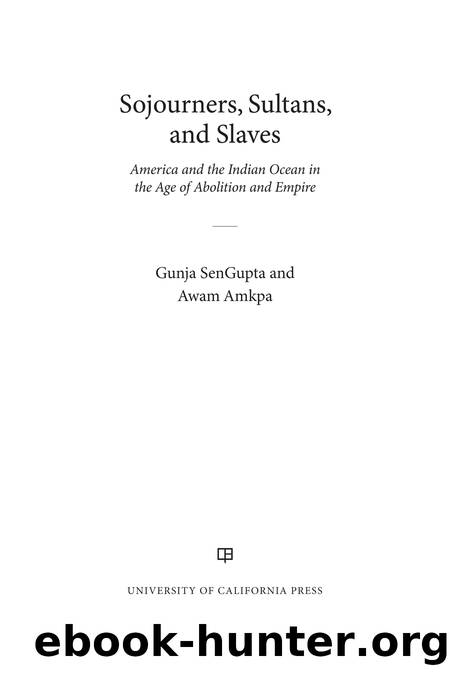Sojourners, Sultans, and Slaves by Gunja SenGupta;Awam Amkpa;

Author:Gunja SenGupta;Awam Amkpa;
Language: eng
Format: epub
ISBN: 9780520389137
Publisher: University of California Press
IMAGINING MARIANAHâS PASSAGE TO INDIA: THE GAZE OF IMPERIAL ABOLITION
During 1842â43, Lieutenant W. Christopher, Commander of the HC Brig of War Tigris, was on a mission to accompany His Excellency Ally Bin Naseer (as his name is spelled in British colonial archives), envoy extraordinary for the Imam of Muscat to her Britannic majesty, from the Persian Gulf back to East Africa. The report Christopher wrote of his travels established a direct connection between slave-grown American cotton and Indian Ocean slavery on many levels. The first was through the workings of international trade. The Americans, he wrote, traded âwith our Indian subjects nearly always, and their clothes return with the slave dealer into the heart of Africa.â Second, he remarked upon proslavery defenses among Arab slaveholding âpaternalistsâ that appeared to bear an uncanny resemblance to the rationales of American slaveholders. Finally, he portrayed the Zanzibar slave market as a mirror image of Atlantic auction blocks.27
En route from Muscat to Zanzibar, Christopher sought to engage Naseer in a conversation about the merits of free versus slave labor. The Omani, who claimed to own sixty to seventy slaves to perform the work of his Zanzibar household, warned that âshould [the Imam] put a stop to buying and selling servants, [he] would .â.â. infuriate his people.â He defended slavery with the argument that âWe find them naked, hungry .â.â. We save their children, and bring them up as our children and true believers.â Christopher concluded that âThese are the usual arguments used by Mahomedans, the great traffickers in human bodies to dispel their own scruples.â28
Upon reaching their destination, Christopher found the island to be âbeautifully fertile,â especially compared with âsterileâ Oman, suffering only from the drawback of harboring a one- to two-mile band of swamplands that surrounded the âfilthy town of Zanzibarâ on three sides and bred frightful fevers. Its ruler, the Imam, commanded twelve hundred slaves. Upon invitation, the British lieutenant visited the monarchâs clove plantations as well as his two palaces, which boasted âloop holed upper stories.â He wandered through halls paved with marble flags and passed niches ornamented with porcelain or glassware. Large mirrors hung in the rooms. The British officerâs tour guide was the twenty-two-year-old âvery communicativeâ son of a âhigh functionary,â who was âdressed in rich Arab costume, and rode a bay palfrey of the 1st blood.â His late mother was a French woman who had spent her youth in the zenana of a ârich Mussalmanâ in Muscat. Christopher noted that âthe plantations have a most pleasing appearance.â The Imam had constructed an aqueduct extending two thousand yards into the woods to convey water âas pure as crystalâ through the palace to the beach. The clove trees, he reported, were planted âon the oldest soil or higher grounds of the island at about 14 feet apart, the intervals being kept well weeded .â.â., the dead branches being cut off.â The oldest trees, âbushy and of circular formâ grew as tall as forty feet. He estimated the output at one
Download
This site does not store any files on its server. We only index and link to content provided by other sites. Please contact the content providers to delete copyright contents if any and email us, we'll remove relevant links or contents immediately.
| Central Africa | East Africa |
| North Africa | Southern Africa |
| West Africa | Algeria |
| Egypt | Ethiopia |
| Kenya | Nigeria |
| South Africa | Sudan |
| Zimbabwe |
Goodbye Paradise(2972)
Men at Arms by Terry Pratchett(2408)
Tobruk by Peter Fitzsimons(2064)
Pirate Alley by Terry McKnight(1911)
Arabs by Eugene Rogan(1840)
Borders by unknow(1791)
Belonging by Unknown(1472)
The Biafra Story by Frederick Forsyth(1327)
It's Our Turn to Eat by Michela Wrong(1305)
Botswana--Culture Smart! by Michael Main(1239)
A Winter in Arabia by Freya Stark(1226)
Gandhi by Ramachandra Guha(1197)
Coffee: From Bean to Barista by Robert W. Thurston(1184)
Livingstone by Tim Jeal(1153)
The Falls by Unknown(1142)
The Source by James A. Michener(1135)
The Shield and The Sword by Ernle Bradford(1102)
Egyptian Mythology A Fascinating Guide to Understanding the Gods, Goddesses, Monsters, and Mortals (Greek Mythology - Norse Mythology - Egyptian Mythology) by Matt Clayton(1088)
Africa: Altered States, Ordinary Miracles by Richard Dowden(1080)
